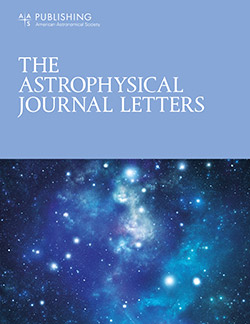Quasi-simultaneous Optical Flux and Polarization Variability of the Binary Super Massive Black Hole Blazar OJ 287 from 2015 to 2023: Detection of an Anticorrelation in Flux and Polarization Variability
IF 8.8
1区 物理与天体物理
Q1 ASTRONOMY & ASTROPHYSICS
引用次数: 0
Abstract
Abstract We study the optical flux and polarization variability of the binary black hole blazar OJ 287 using quasi-simultaneous observations from 2015 to 2023 carried out using telescopes in the USA, Japan, Russia, Crimea, and Bulgaria. This is one of the most extensive quasi-simultaneous optical flux and polarization variability studies of OJ 287. OJ 287 showed large amplitude, ∼3.0 mag flux variability, large changes of ∼37% in degree of polarization, and a large swing of ∼215° in the angle of the electric vector of polarization. During the period of observation, several flares in flux were detected. Those flares are correlated with a rapid increase in the degree of polarization and swings in electric vector of polarization angle. A peculiar behavior of anticorrelation between flux and polarization degree, accompanied by a nearly constant polarization angle, was detected from JD 2,458,156 to JD 2,458,292. We briefly discuss some explanations for the flux and polarization variations observed in OJ 287.2015 - 2023年双星超大质量黑洞Blazar oj287的准同步光通量和偏振变异性:通量和偏振变异性的反相关探测
摘要利用2015 - 2023年在美国、日本、俄罗斯、克里米亚和保加利亚的望远镜进行的准同步观测,研究了双黑洞耀变体oj287的光通量和偏振变异性。这是对oj287最广泛的准同时光通量和偏振变异性研究之一。OJ 287表现出较大的振幅,磁通可变性为~ 3.0,极化度变化幅度为~ 37%,极化电矢量角度摆动幅度为~ 215°。在观测期间,发现了几个通量耀斑。这些耀斑与极化度的快速增加和极化角的电矢量的波动有关。从JD 2,458,156到JD 2,458,292,发现了通量与极化度之间的特殊反相关行为,并伴有近乎恒定的极化角。我们简要讨论了oj287中观测到的通量和极化变化的一些解释。
本文章由计算机程序翻译,如有差异,请以英文原文为准。
求助全文
约1分钟内获得全文
求助全文
来源期刊

Astrophysical Journal Letters
ASTRONOMY & ASTROPHYSICS-
CiteScore
14.10
自引率
6.30%
发文量
513
审稿时长
2-3 weeks
期刊介绍:
The Astrophysical Journal Letters (ApJL) is widely regarded as the foremost journal for swiftly disseminating groundbreaking astronomical research. It focuses on concise reports that highlight pivotal advancements in the field of astrophysics. By prioritizing timeliness and the generation of immediate interest among researchers, ApJL showcases articles featuring novel discoveries and critical findings that have a profound effect on the scientific community. Moreover, ApJL ensures that published articles are comprehensive in their scope, presenting context that can be readily comprehensible to scientists who may not possess expertise in the specific disciplines covered.
 求助内容:
求助内容: 应助结果提醒方式:
应助结果提醒方式:


